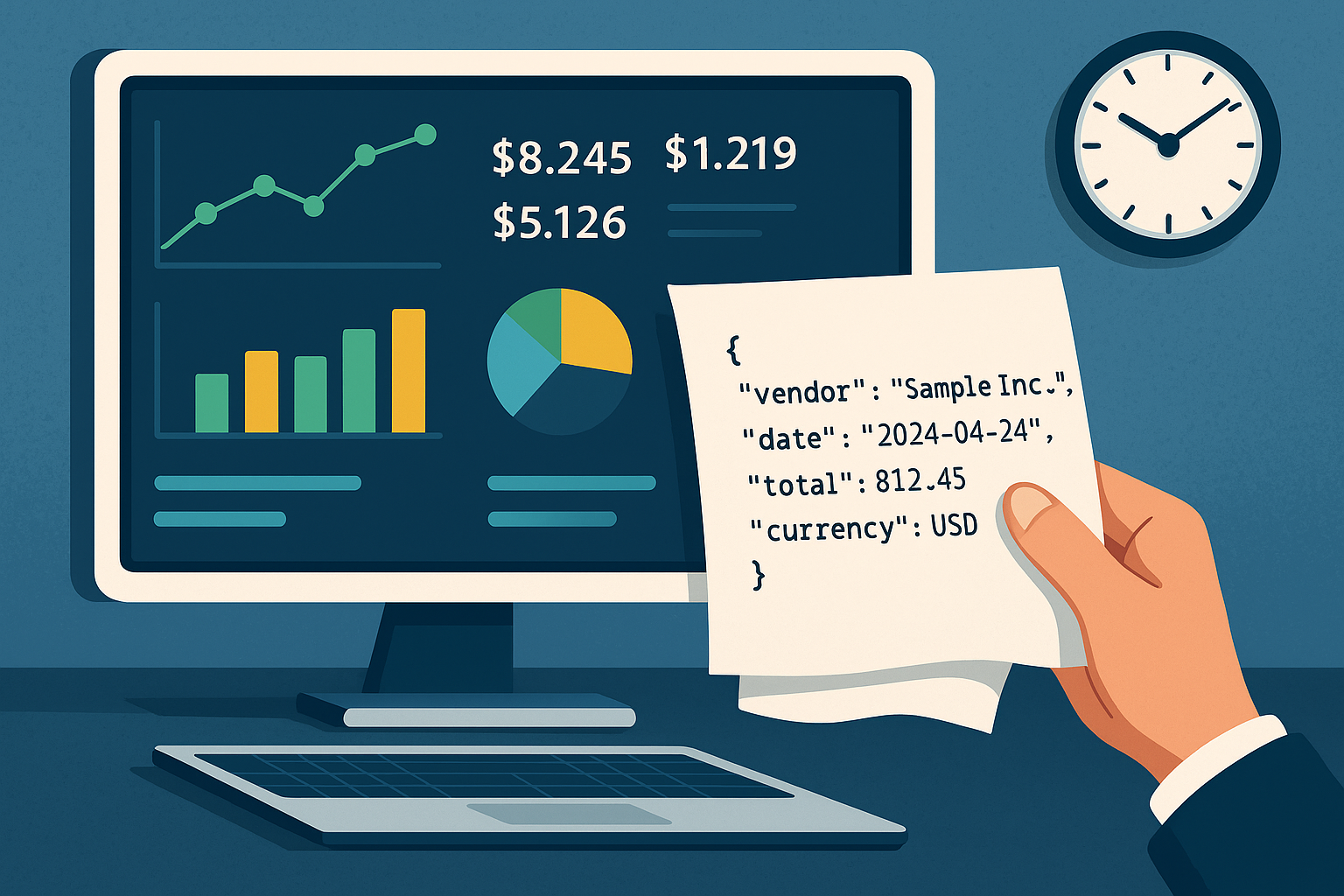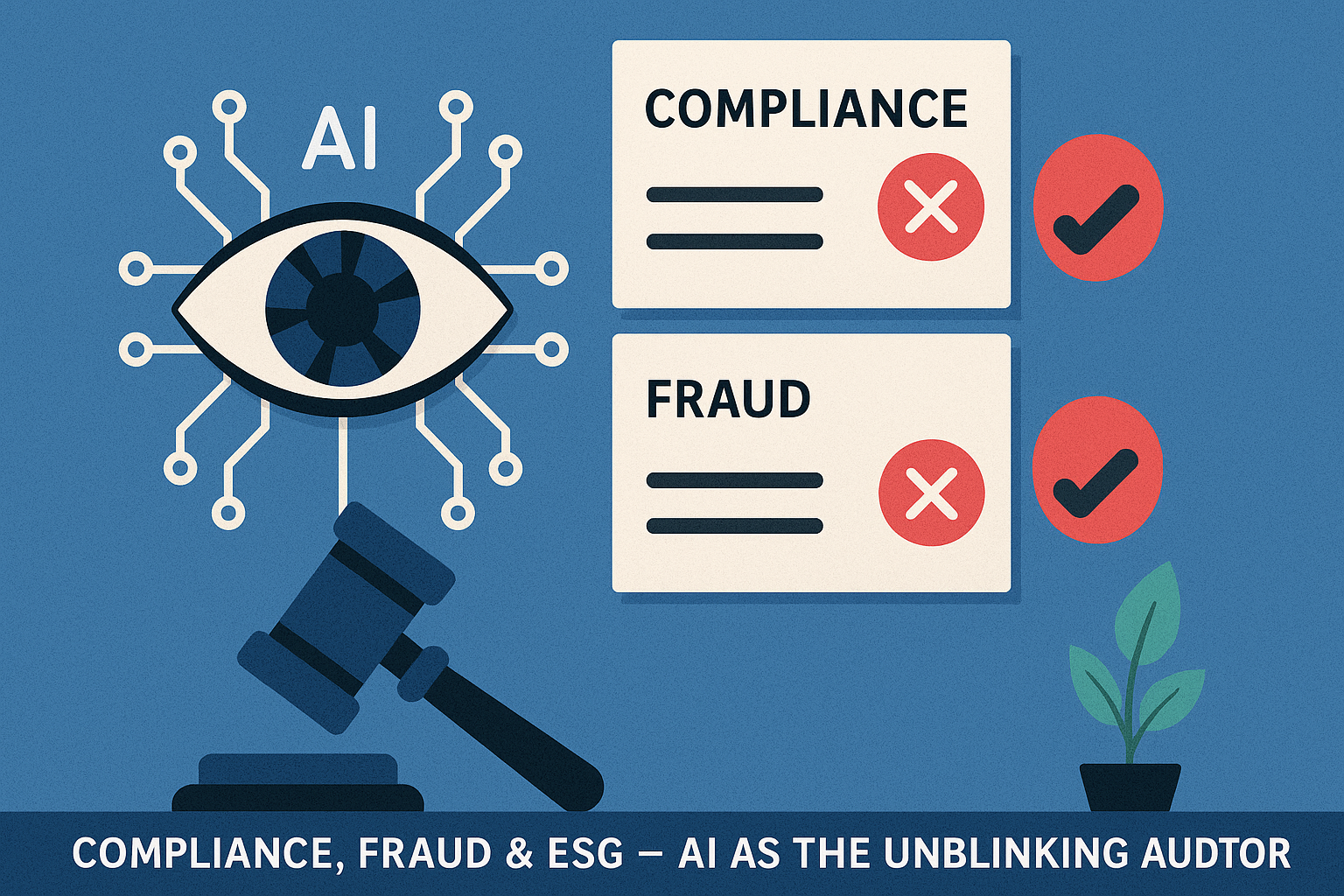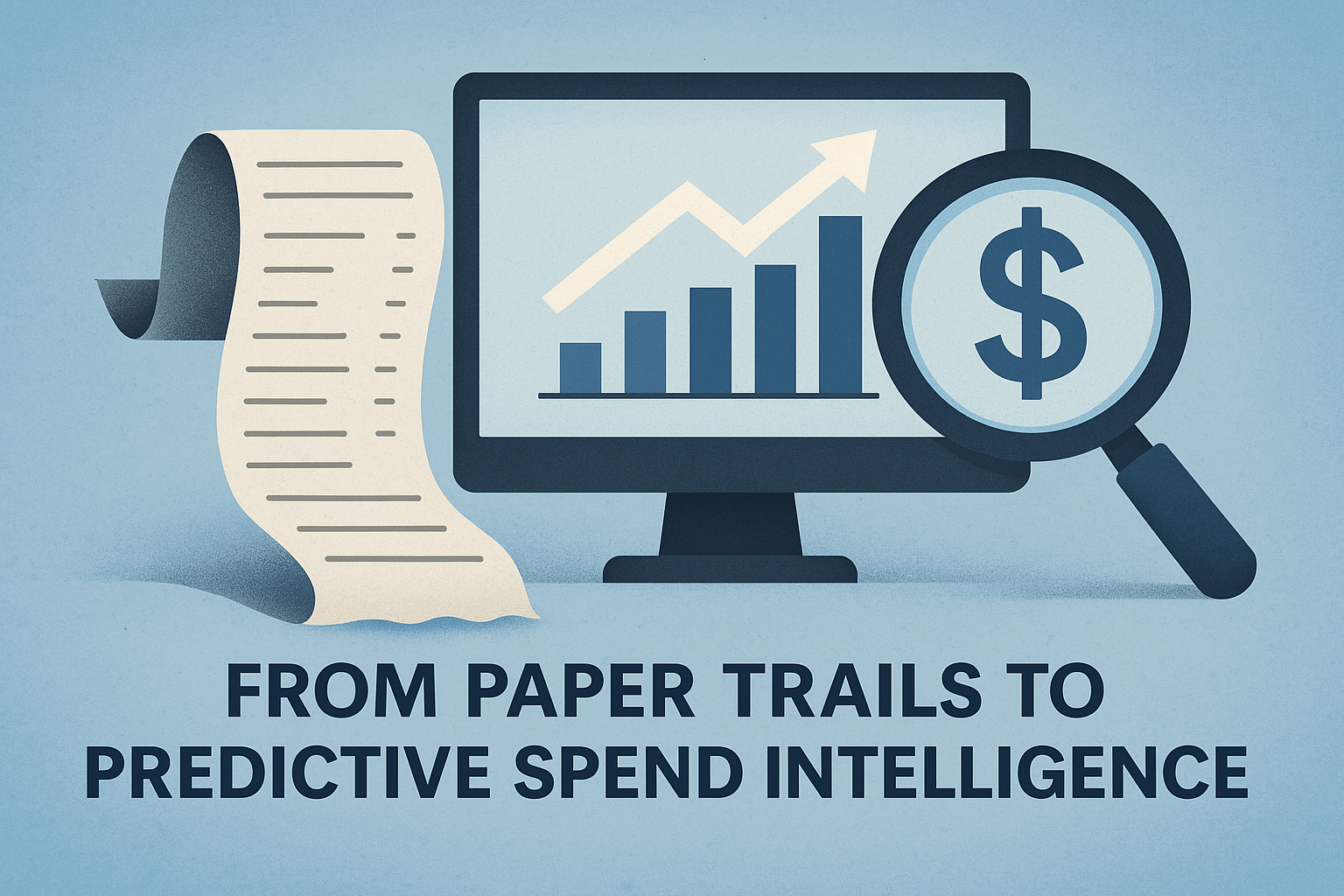Expense Reports: Turning Receipts into Data
Introduction — Why Expense Reporting Still Hurts in 2025
Despite years of investment in financial systems and digital workflows, expense reporting remains one of the last manual pain points in enterprise operations. Employees still snap photos of paper receipts, transcribe line items into spreadsheets or portals, and wait days or even weeks for reimbursement. Meanwhile, finance teams chase missing information, correct formatting errors, and manually reconcile expense categories. This isn’t just an inconvenience — it’s a strategic inefficiency hiding in plain sight.
The issue isn’t technology availability — it’s technology adoption. While payroll, invoicing, and procurement have become largely automated, expense reports have lagged behind, bogged down by inconsistent formats, handwritten totals, faded thermal paper, and edge-case exceptions. These pain points have turned what should be a routine process into a productivity drain for both employees and finance teams.
From the CFO’s perspective, the implications go deeper than just time and labor. Manual expense handling creates three major liabilities:
Delayed visibility into spend: When receipt data trickles in over days or weeks, organizations lose the ability to monitor T&E costs in real time. That impairs cash flow forecasting and limits responsiveness to budget deviations.
Increased compliance risk: Without structured, verifiable data, it becomes harder to enforce spending policies or flag fraudulent claims. Audit preparation becomes a fire drill rather than a transparent review.
Employee dissatisfaction: Reimbursement delays and clunky submission processes create frustration among staff, especially for frequent travelers or client-facing teams.
Fortunately, the tools to fix this problem have finally matured. AI-powered OCR (Optical Character Recognition) now enables real-time extraction of key fields — such as vendor, date, total, and tax — from receipts, no matter how crumpled, faded, or poorly lit. Employees can simply snap a photo and upload it. Within seconds, clean, structured data is routed directly into financial systems. No spreadsheets. No back-and-forth emails. No delays.
This isn’t about digitizing paper — it’s about transforming the speed, accuracy, and utility of expense data. Instead of treating receipts as static records, forward-looking finance leaders now see them as live data assets. When captured and processed instantly, they unlock real-time analytics, policy enforcement, and early detection of risk — all without adding headcount.
In 2025, expense automation is no longer a question of feasibility. It’s a question of leadership. The organizations that act now won’t just save money — they’ll gain a competitive edge in agility, compliance, and employee satisfaction. The following sections will explore the true cost of manual workflows, the AI technology that makes instant expense capture possible, and the strategic decisions that will define the next generation of financial operations.
The Hidden Cost of Manual Expense Reports
At first glance, processing employee expenses may seem like a low-stakes administrative function. But when done manually, it becomes a silent drain on time, money, and compliance — scaling in impact as the company grows. For C-level executives focused on operational efficiency, cost control, and risk management, this is a blind spot that demands attention.
Direct Financial Impact
Every manually submitted expense report comes with an invisible price tag. Beyond reimbursement amounts, organizations incur administrative costs associated with reviewing, correcting, and entering data. Studies estimate the average cost to process a single expense report manually ranges from $45 to $60, depending on region and process maturity. Multiply that by thousands of receipts per quarter, and it quickly becomes a six- or seven-figure annual burden.
Errors are common — missed fields, incorrect amounts, duplicate entries — and they carry their own correction costs. Finance teams are forced into low-value tasks like chasing receipts, verifying totals, and rechecking expense codes, creating opportunity costs across more strategic finance initiatives.
Delayed Visibility and Decision-Making
Manual workflows create lag. Employees often delay submissions until the end of the month or trip, meaning data doesn’t reach finance in real time. By the time controllers or CFOs see consolidated T&E reports, they’re weeks old — too late to respond to overspending, enforce category caps, or spot deviations from budget.
That delay also impacts cash flow forecasting. Without timely data on reimbursements, travel commitments, or vendor charges, finance teams are forced to rely on rough estimates and padded buffers — reducing the precision of forecasts and increasing the risk of poor working capital decisions.
Compliance and Audit Exposure
When data is fragmented across emails, spreadsheets, and PDF scans, policy enforcement becomes reactive and inconsistent. Auditors may find expenses without receipts, missing approvals, or out-of-policy claims that went unnoticed in manual reviews. Over time, this erodes the integrity of financial controls and exposes the company to reputational and regulatory risk.
In high-regulation industries like pharmaceuticals, finance, and government contracting, failing to maintain proper documentation for expenses can lead to significant fines, disqualification from contracts, or reputational damage. Even in less regulated sectors, internal fraud — such as submitting the same receipt twice or inflating totals — is harder to detect without structured, centralized data.
Employee Experience and Productivity Loss
Employees hate filing expense reports, and it shows. It’s one of the most complained-about internal processes in corporate life. Sales teams on the road, consultants in the field, and executives managing multiple clients all lose hours each month on tedious submissions. That’s time pulled away from revenue-generating work.
Moreover, delayed reimbursements frustrate staff, especially when large sums are personally covered. A clunky process undermines the employee experience, which can affect morale, retention, and productivity — particularly for high-value personnel with frequent travel obligations.
Manual expense reporting doesn’t just cost money — it costs speed, insight, trust, and satisfaction. Forward-looking organizations are recognizing this and moving toward intelligent automation. In the next section, we’ll explore how modern OCR technology is changing the game, making it possible to extract key data from even the messiest receipts in seconds — without human effort.
Snap, Upload, Done — How Modern OCR Turns Crumpled Paper into Clean Data
In today’s fast-moving business environment, manual data entry is a relic of the past — and expense reporting is no exception. Thanks to advances in AI-powered OCR (Optical Character Recognition), employees can now simply snap a photo of a receipt, upload it, and move on. Behind the scenes, powerful cloud-based systems extract the relevant information in seconds, with no spreadsheets or manual typing required.
From Messy Paper to Structured Data
Modern OCR has come a long way from the brittle, error-prone systems of the past. Today’s solutions are trained on massive datasets that include a wide range of real-world receipt formats, languages, currencies, and lighting conditions. They are built to handle:
Crumpled or folded receipts
Low-light photos and blurry images
Faded thermal print
Receipts in multiple languages or character sets
Complex layouts and handwritten notes
Where older systems often failed unless conditions were perfect, current-generation OCR extracts key fields such as vendor name, transaction date, total amount, tax breakdown, and currency with remarkable precision — even under suboptimal conditions.
The Intelligence Behind the Simplicity
The process might feel effortless for the end user, but it’s powered by a sophisticated pipeline of AI-driven steps:
Preprocessing the image: Before extraction begins, the receipt photo is cleaned and enhanced. This involves removing the background, correcting for poor lighting, de-skewing, and increasing contrast to improve text clarity.
Detecting the layout: Rather than reading every word on the page, the system first understands the structure of the receipt — identifying where the vendor information, total, date, and tax details are typically located, even if the layout varies.
Extracting and interpreting fields: AI models then isolate the relevant fields, distinguishing between similar-looking data points such as subtotal vs. total, or date of service vs. date of issue.
Scoring confidence: Each extracted field is evaluated for accuracy. When the system has low confidence in a particular value — due to poor image quality or unclear formatting — it can be flagged for review or reprocessed, depending on workflow settings.
Understanding regional differences: Receipts don’t follow global standards. Modern OCR systems adapt to local tax rules, currency symbols, and date formats, ensuring that a receipt from London is interpreted just as accurately as one from São Paulo or Tokyo.
What This Means for Business Leaders
The operational impact is significant. Finance teams no longer need to sift through emails or PDFs to find receipts. Employees can submit expenses in real time — on the go, right after a client lunch or ride-share trip. And the data captured isn’t just readable — it’s ready to use, structured and compatible with ERP, accounting, and business intelligence systems.
This creates a ripple effect across the organization:
Controllers close books faster with more accurate T&E data
CFOs gain real-time visibility into travel and discretionary spend
Compliance officers benefit from automated, auditable recordkeeping
Employees experience faster reimbursements and less administrative hassle
In short, modern OCR has transformed receipt capture from a manual, error-prone task into an automated, scalable process that drives both operational efficiency and strategic insight.
In the next section, we’ll look at how this instant data capture flows directly into finance dashboards, enabling organizations to shift from reactive reporting to real-time spend intelligence.
Real-Time Finance Dashboards: From Snapshots to Strategic Insight
Capturing receipt data is only the first step. The real value lies in what happens next: transforming that data into live financial intelligence. With modern AI-powered OCR systems, expense information doesn’t just get stored — it gets streamed directly into your financial stack, enriching dashboards, improving forecasts, and enabling faster, more confident decision-making at every level of the organization.
From Static Receipts to Dynamic Reporting
In traditional workflows, expense data is gathered manually, validated in batches, and added to reports days or even weeks after the transaction. This time lag creates blind spots. For CFOs, controllers, and FP&A teams, outdated expense data translates into inaccurate forecasts, bloated buffers, and missed opportunities to optimize spend.
By contrast, AI-driven receipt processing enables real-time ingestion of structured data. As soon as an employee submits a receipt, key fields — like total, vendor, category, and tax — are automatically extracted and pushed into finance systems via APIs or webhooks. There’s no waiting for end-of-month uploads. Data starts flowing immediately.
This enables finance leaders to move from reactive to proactive:
Monitor travel and entertainment (T&E) spend as it happens.
Detect and correct overages before they snowball.
Track spend against budget targets with near real-time accuracy.
Dashboards That Empower, Not Just Inform
Real-time data unlocks dashboards that don’t just display numbers — they tell a story. Executives can instantly see:
Current spend by department, region, or individual.
Top vendors by volume and value.
Policy violations, such as unauthorized categories or unapproved merchants.
Reimbursement cycles and workflow bottlenecks.
Instead of relying on post-close reports or static spreadsheets, CFOs can interact with living dashboards that surface exceptions, trends, and opportunities for intervention. This enhanced visibility reduces the need for guesswork and allows finance leaders to make faster, smarter decisions with greater confidence.
Improved Forecasting and Planning
When expense data is processed in real time, forecast accuracy improves. Predictive models have access to the freshest inputs, reducing the need for manual adjustments or conservative estimates. Teams can model spend trajectories, test policy changes, and refine cash-flow strategies based on what’s happening today — not last quarter.
For organizations with decentralized operations or distributed teams, this real-time feedback loop is especially critical. It ensures that local activity doesn’t go unnoticed until after the fact, and that global leaders can maintain oversight without micromanagement.
Seamless System Integration
Modern OCR solutions are designed to integrate with the broader finance tech stack. Whether your organization uses a large ERP system like SAP or Oracle, a cloud-native solution like NetSuite, or lightweight tools like QuickBooks and Power BI, structured receipt data can be routed directly into existing pipelines.
This ensures that the investment in automation delivers value immediately — no need for system overhauls or disruptive change management. Data is enriched, validated, and visualized in the tools your teams already use, accelerating adoption and amplifying ROI.
With real-time OCR and intelligent dashboards, expense reporting becomes more than a compliance requirement — it becomes a strategic advantage. It gives CFOs instant access to spending patterns, enables faster course correction, and unlocks agile forecasting. In the next section, we’ll explore how this same infrastructure enhances compliance and fraud prevention while supporting broader ESG and governance goals.
Compliance, Fraud & ESG — AI as the Unblinking Auditor
For C-level executives, expense reporting is more than a matter of operational efficiency — it’s a critical vector for governance, risk, and compliance. Manual processes create blind spots that can lead to undetected fraud, audit exposure, and even reputational damage. But with AI-powered automation, every receipt becomes a checkpoint — reviewed in real time, validated against policy, and logged for future audits. The result is a continuously vigilant, self-auditing expense ecosystem.
Policy Enforcement at Machine Speed
In manual workflows, policy checks are often skipped, applied inconsistently, or retroactively enforced. An analyst might spot a late-night meal over the per diem limit — or they might not. But AI removes the guesswork. As receipts are processed, automation engines can instantly:
Validate vendor categories against internal policy (e.g., no alcohol on client entertainment budgets).
Flag submissions outside of approved travel windows or locations.
Detect personal expenses disguised as business costs.
These checks happen automatically — at the point of capture — not weeks later during a quarterly review. This ensures policy compliance becomes embedded in the workflow, not bolted on as an afterthought.
Real-Time Fraud Detection
Fraudulent expense claims — whether deliberate or accidental — are difficult to detect manually, especially across large organizations. But AI dramatically improves the odds of catching them early. By analyzing patterns across users, locations, vendors, and timestamps, modern systems can detect anomalies such as:
Duplicate receipts submitted by the same or different employees.
Unusual spending behaviors, such as frequent high-value cash expenses or repeated non-itemized claims.
Logo mismatches or tampered images, using AI-driven brand recognition and forensic analysis to verify the authenticity of receipts.
When suspicious claims are identified, the system can automatically flag them for review, escalate to finance, or even trigger a secondary approval path. This kind of proactive fraud control not only prevents losses — it builds a culture of accountability.
Audit-Ready Documentation
Audits, whether internal or external, are simplified when every receipt is digitized, timestamped, and automatically categorized. There's no need to chase paper trails or rely on inconsistent naming conventions. Auditors gain access to a clear, searchable, and well-structured database of transactions, complete with metadata and processing logs.
For regulated industries such as pharmaceuticals, finance, energy, or public sector organizations, demonstrable compliance is not optional. Automated documentation strengthens audit posture and reduces the risk of fines, contract losses, or reputational damage.
Supporting ESG Goals Through Digital Expense Management
Expense automation also supports broader environmental, social, and governance (ESG) initiatives. By eliminating paper trails, couriered receipts, and in-person approvals, companies reduce waste, cut carbon from administrative travel, and embrace more sustainable workflows.
From a governance standpoint, AI-powered systems enhance transparency and fairness, ensuring that policies are applied consistently across departments, regions, and roles. This reduces bias, promotes equitable enforcement, and supports a strong ethical foundation for corporate conduct.
With intelligent automation, expense reporting transforms from a back-office process into a strategic compliance asset. Fraud risks are minimized. Policy adherence becomes automatic. Audits become routine rather than disruptive. And sustainability goals gain measurable momentum.
In the next section, we’ll explore the strategic choices executives face when building or buying their AI expense infrastructure — and how to align those decisions with business goals, resource availability, and competitive advantage.
Build, Buy, or Blend — Crafting the Right AI Stack for Expense Automation
Once the value of automating expense reporting is clear, the next strategic question emerges: How should your organization implement it? Should you purchase a ready-to-use solution, build a custom pipeline tailored to your needs, or combine both approaches in a blended strategy?
For C-level decision-makers, this isn’t a purely technical choice. It’s about aligning automation investments with long-term goals, resource availability, risk tolerance, and competitive priorities.
Buying Ready-Made APIs for Fast Deployment
For organizations seeking rapid results with minimal engineering overhead, buying off-the-shelf AI services is the most direct path. Cloud-based OCR APIs — like those designed specifically for receipt parsing — offer high accuracy, multilingual support, and flexible integration with your existing systems.
These APIs are optimized for real-world use cases: they handle low-quality images, support various currencies and tax formats, and provide structured outputs that can plug directly into ERPs, expense management tools, or BI dashboards.
The key advantage here is speed to value. There’s no need to train models, annotate datasets, or manage infrastructure. A basic integration can often be completed in days or weeks. For organizations looking to modernize without deep in-house AI expertise, this approach offers a clear ROI with low implementation risk.
Building Custom Solutions for Strategic Differentiation
While buying may suffice for many use cases, some enterprises require deeper control. Organizations with unique policies, complex regional tax structures, or strict data residency requirements may find that custom AI development offers long-term strategic benefits.
A custom solution allows your teams (or trusted AI partners) to train models on proprietary datasets, fine-tune them for niche formats or edge cases, and embed the logic of your specific policy framework. You can also choose your infrastructure — whether cloud, hybrid, or on-premise — and optimize for performance, cost, or compliance.
Although this route demands more upfront investment — in both time and budget — it can pay off in reduced operating costs, greater accuracy, and tighter alignment with internal workflows. It also opens the door to deeper innovation, such as combining OCR with internal knowledge graphs, predictive budget analytics, or intelligent approval routing.
Blending APIs and Custom Logic for Scalable Flexibility
For many enterprises, the optimal approach lies between these extremes. Start with robust, proven APIs to establish the foundation quickly — then extend, adapt, and enhance based on evolving needs. This blended model offers agility with room to grow.
For example, your team might use a cloud OCR API to extract receipt data, then run that data through a custom-built policy engine or fraud detection module. Or you might begin with off-the-shelf components and gradually replace them with proprietary models for key regions, languages, or business units.
This incremental path lets you de-risk your AI roadmap, prioritize high-impact use cases, and adapt over time — without committing prematurely to either extreme.
Strategic Considerations for Executive Decision-Making
As you weigh these options, consider the following questions:
How critical is expense data to your broader financial strategy?
Do your compliance needs or geographic footprint require tailored AI capabilities?
What internal resources — technical, financial, operational — can support a build or blend approach?
Where will automation deliver the most value in the next 6, 12, or 24 months?
Organizations that think strategically about this build-buy-blend decision don’t just automate a process — they architect a scalable intelligence layer that strengthens finance, governance, and operations for years to come.
In the final section, we’ll explore how these technologies shift expense data from a back-office burden into a front-line enabler of strategic insight, speed, and agility.
Conclusion — From Paper Trails to Predictive Spend Intelligence
What was once a tedious administrative task — collecting, submitting, and reviewing paper receipts — has become a powerful opportunity for digital transformation. Expense reports are no longer just about compliance or reimbursement. When automated with AI and integrated into your finance stack, they become strategic data streams that fuel real-time decision-making, operational agility, and long-term value creation.
For C-level leaders, the implications are clear:
Faster month-end close cycles free up finance teams to focus on forecasting and strategy — not data entry.
Real-time visibility into spend empowers more agile budget management, with fewer surprises and more informed trade-offs.
Built-in compliance and fraud detection reduce risk exposure while strengthening internal controls and audit readiness.
Better employee experience enhances productivity and morale, especially for mobile teams and high-performing client-facing staff.
Support for ESG and digital governance goals ensures that automation aligns not just with cost savings, but also with enterprise-wide priorities.
The technology is here. Modern OCR solutions can capture key data from receipts with precision and speed. Dashboards can reflect spend insights in real time. AI-driven logic can enforce policy before violations occur. And organizations can choose to adopt this transformation through flexible strategies — buying off-the-shelf tools, building tailored systems, or blending both.
The question isn’t whether your expense process can be automated. The question is how soon your organization will move — and whether that move will simply eliminate inefficiency, or unlock an entirely new level of financial intelligence.
By turning static receipts into dynamic data, you turn every transaction into a moment of visibility, control, and strategic opportunity.
Now is the time to modernize. To move beyond the spreadsheet slog. To treat expense data not as a cost of doing business, but as a source of competitive advantage. The journey begins with a single photo — and the right AI behind it.






